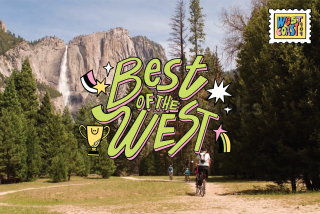The oohs and ahhs of it all
- Share via
SARATOGA, WYO. — Saratoga, Wyo.
My first night in Saratoga, the Hobo Pool lived up to its reputation as a communal public bath.
Two sunburned young men flaunting tattoos and burly arms -- roughnecks working natural gas rigs -- stood waist deep in the sulfurous waters. Skinny backpackers just down from the national forest washed off the trail dust before changing into street clothes. Tourists mingled with ranch hands. And the townies, not bothering with the changing rooms, showed up in bathrobes and slippers, seeking a quick soak before bed.
Long before the transcontinental railroad brought settlers into southern Wyoming, Native Americans bathed in these mineral hot springs. The settlers called the town Warm Springs originally, then in 1876 renamed it Saratoga after the New York resort, hoping to lure tourists and rheumatics.
The Hobo Pool -- so called because it once gave succor to transients and carefree cowboys -- remains free and open 24 hours a day.
Saratoga sits at the head of the North Platte River Valley, bordered on the west by the Sierra Madre and to the east by the towering Snowy Range, both part of the Medicine Bow National Forest. The valley is quintessential Wyoming, a landscape of buttes, mountains, river breaks and sagebrush plains. Working cattle ranches occupy the valley floor, and wildlife -- elk, pronghorn antelope, mule deer, moose and other critters -- meander through the foothills and along roadways.
With its hot springs, nearby mountains and superb trout fishing in the North Platte, Saratoga is a natural tourist attraction. But unlike nearby Steamboat Springs, Colo., or Jackson Hole, in northwestern Wyoming, Saratoga is still small (population 1,700), unpretentious and more authentically Western because, tourism aside, ranching remains the valley’s economic mainstay.
But it’s not all agrarian, just-plain-folks. The Old Baldy Club -- a private golf and fishing resort -- hosts an exclusive membership. Film stars and other luminaries are sometimes sighted on the river or in gift shops downtown. When I visited Saratoga in late July last year, I first took a room at the Hotel Wolf, a historic redbrick structure done in Victorian furnishings.
I had planned to hire a guide and fish the Platte with a childhood friend who lives nearby, but his work schedule didn’t coincide with my vacation. Instead, I rented a canoe for a six-hour (10-mile) float and brought along Hannah, his 15-year-old daughter. She was an amiable companion but no fly fisher and was more interested in hearing incriminating stories about her father’s teen years.
I kept his confidences and instead gave her a natural history lesson on Western bird life. As we paddled out of town, the river cut through bluffs and sagebrush-covered hills. In this dry landscape, the Platte’s lush, riparian forest of cottonwoods was a magnet for wildlife.
We rounded bends and spooked mule deer wading across the shallows. Out on the plains, we saw pronghorn grazing the sagebrush. A bald eagle glided overhead. It was a relaxing and easy float.
I took day trips into the national forest and mountain biked at the South Brush Creek Visitors Center and Bottle Creek campgrounds. Both have trail systems constructed for cross-country skiing with gentle hills.
In the late afternoons, I shopped for Western art and jewelry in the galleries, sampled the restaurants and sat on the Wolf Hotel’s spacious front porch watching the traffic go by.
On my final day, I drove 25 miles east on Wyoming 130 to where it crosses the Snowy Range. At the summit of the road, the southern face of Medicine Bow Peak plunges 2,000 feet to an alpine tundra of lakes and white-granite boulders. In July, when a carpet of wildflowers covers the meadows, it is an especially sublime landscape.
The trail to Medicine Bow Peak is just 4 1/2 miles but begins at 10,400 feet, climbs steeply out of the tree line and crests at the mountain’s 12,013-foot summit. I planned a circular route of eight miles. Several times, I stopped, breathless, my head and heart thumping.
While I rested, I pulled binoculars from my pack and took in the view. To the east lay the Laramie Plains; to the south, Longs Peak (14,259 feet) stood way off in Colorado; and west and north past the Platte Valley sprawled the empty high plains of central Wyoming.
I walked on and passed through meadows covered with alpine phlox, bottlebrush and other wildflowers. Farther up, talus, or shattered rock, replaced the soil. In the final 200 yards, I leaped from boulder to boulder and nearly got knocked down by the wind whipping across the summit. I ate lunch wedged into a calm space between two boulders, looking down on the glacially carved lakes that sparkled silver.
That night in Saratoga, I celebrated with a “wolf steak” -- a sirloin at the Wolf Hotel -- and then checked into the Saratoga Inn to experience its hot springs, a large, naturally heated swimming pool and a series of pools that had graduating temperatures.
After a nap, I left my room around 1 a.m. and submerged up to my neck in one of the smaller pools. I took in the cool night air and stared up through the steam at thestars . Perhaps no real medicinal properties existed in those mineral-laden waters, but the experience was positively restorative.
More to Read
Sign up for The Wild
We’ll help you find the best places to hike, bike and run, as well as the perfect silent spots for meditation and yoga.
You may occasionally receive promotional content from the Los Angeles Times.






